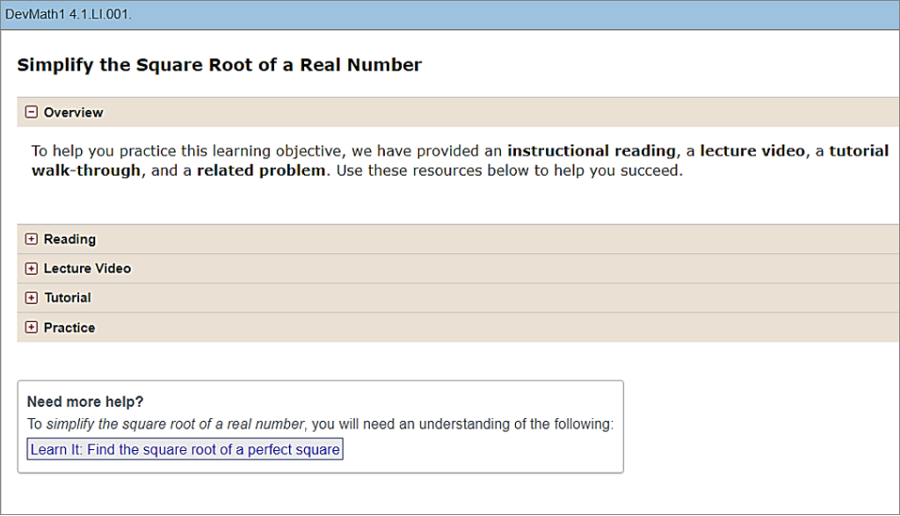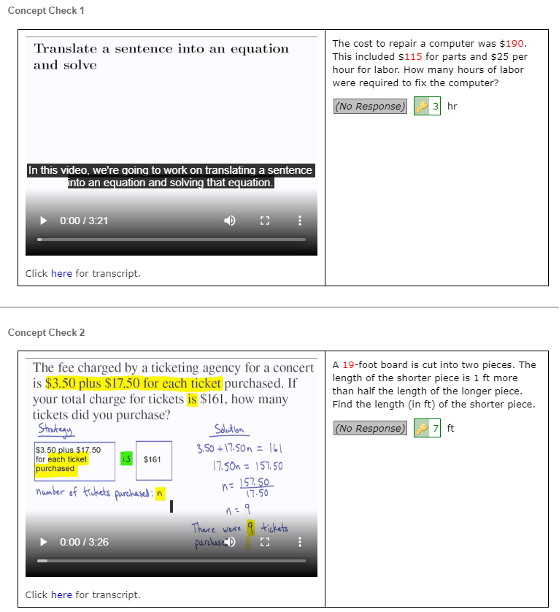Wondering how WebAssign can work for your Developmental Math course? In this blog, you’ll run through four different types of WebAssign modules — Learn Its, Responsive Questions, Concept Checks and Math Mindset Modules — and hear from real instructors who are using them in their own courses.
Learn Its
These mini-lessons tackle your students’ knowledge gaps with just-in-time instruction in a variety of formats to work with their preferred learning style. Students can read about a concept, watch a short video, walk through a problem step by step or just get some extra practice — however they learn, Learn Its adapt to their styles.

Fig 1: A Learn It module in action. Learn Its use multiple formats to help build student understanding, no matter their learning style.
What do instructors think?
“What I’ve seen since I started to incorporate some of the Learn Its in my assignments is it actually reduced the amount of questions my students had for me because I gave them an additional resource and they were able to direct their own learning.”
– Dale Dawes, City University of New York – BMCC
Responsive Questions
Responsive Questions personalize your students’ learning experience by asking them to use real data from their lives as the variables in each question part.

Fig 2: A Responsive Question module in action.
What do instructors think?
“I’ve used the Responsive Questions in WebAssign with my Quantitative Reasoning course where each student encounters project-based learning. The Responsive Questions provide a unique student learning experience on several topics covered in quantitative reasoning where students initiate problem solving with their numeric specifics. The Responsive Questions are contextually similar so students can support one another in their learning efforts to solve the problems. Feedback on their specific situation is provided by WebAssign at each step in the problem.
When students complete the numeric response in WebAssign, I have each student record a video of the Responsive Question problem-solving where they demonstrate their approach and share the concept(s) involved. The Responsive Questions in WebAssign provide students a curious problem-solving situation that involves high student engagement.”
– Mike Lafreniere, Ohio University
Concept Checks
Concept Checks are short, multi-step videos that review key Math concepts. Students are required to answer a question after each video to make sure they understand each concept.

Fig 3: A Concept Check module in action.
What do instructors think?
“This is for all of those visual learners out there. If they don’t like reading text or if they have difficulty when that is presented to them, you can also have these visual problems with videos as an option as well.”
– Willem Wallinga, Bentley University
Math Mindset Modules
Designed for students who might be hesitant towards Math, Math Mindset Modules are interactive and reflective exercises that tackle relevant topics, including a growth mindset and Math anxiety. These modules are designed to reduce fear around Math, and prepare your students for challenging Math topics.

Fig 4: A Math Mindset module in action.
What do instructors think?
“We use the Math Mindset Modules at the beginning of the semester to help the students create a resourceful mindset as well as getting ready for the class. Since our class is a Developmental Math class, our students generally have low Math confidence, but high overall confidence. The videos and reflective questions help the students realize that they can be more confident about Math even when the subject is challenging to them.
We want our students to be confident and resourceful in our classes as well as their other classes. The Math Mindset Modules help shift the students’ belief system from ‘I can’t do Math’ to ‘I can do Math using all of the resources I have available to me.’”
– WendiAnn Sethi, Seton Hall University
More ideas for teaching your Developmental Math course
Looking for more resources for teaching your Developmental Math course with WebAssign? Check out the WebAssign Instructor Help Center for step-by-step WebAssign tutorials.

